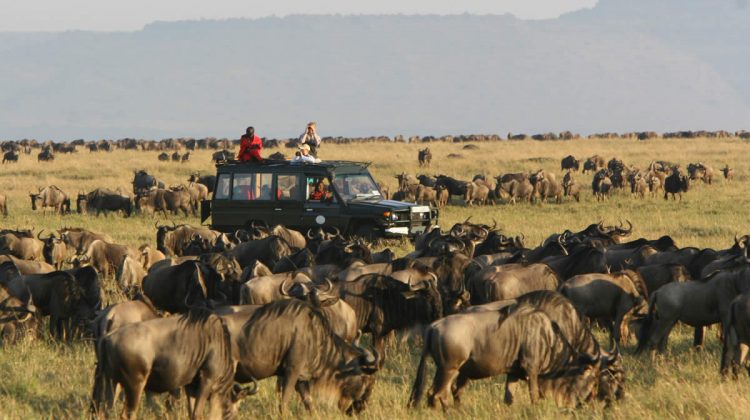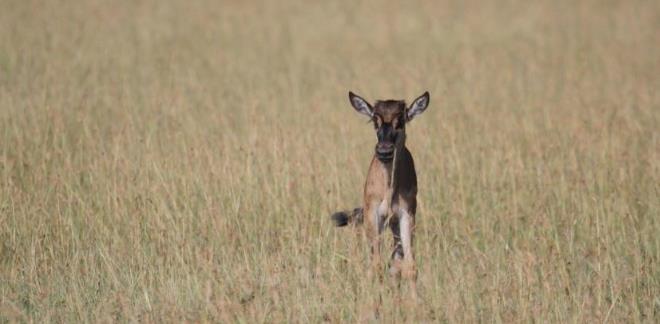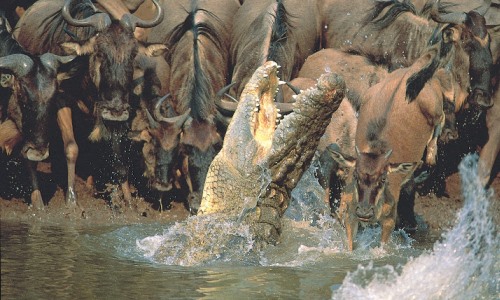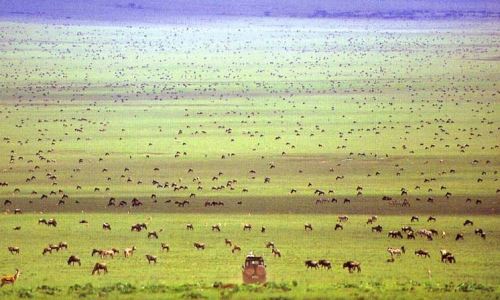Magical Wildebeest Migration

The wildebeest, seemingly assembled from the wreckage of all the other plains species, is one of Africa’s most charismatic creatures. Despite the appearance of an evolutionary calamity, it is also one of the most successful. When herds around two million strong gather together to migrate between the southern parts of the Serengeti National Park and the Masai Mara Game Reserve, you find one of the most dramatic wildlife events on the planet. Such a spectacular event is bound to draw the crowds but there are still ways to enjoy this magical sight in relative isolation.
Wildebeest Migration – when and where to go?
Calving and predator action – January, February, March
Head for the southern Serengeti and the Ndutu area where you find the migration on the famous vast open plains. The visibility is superb, the cows are calving and the predator action is at its highest. Stay at Serengeti Safari Camp, a classic tented camp that moves seasonally to be in the best possible location for all the action.

A young calf, Image credit Singita Grumeti, Eugen Shao
Glorious isolation – June, July
Still in the Serengeti, the wildebeest have made their way into an area known as the western corridor. And it’s here around June and July that the migration tackles its first crossing as it makes its way over the Grumeti River. Tucked away in a remote corner of the reserve and right on the river bank is Grumeti River Camp – a perfect vantage point from which to view the excitement and chaos of a river crossing.
River Crossings – August, September, October
For many, this is the pinnacle of the migration as the great herds dodge the huge crocodiles lying in wait as they stream across the Mara River, drawn to the lush grazing in the Masai Mara. It’s probably the migration at its most exhilarating and among the best places to catch the action is our old favourite Rekero Camp or newcomer Singita Mara Camp. On either side of the Mara River (Rekero on the Kenyan side and Singita Mara in Tanzania) both enjoy remote settings in prime locations with the migration passing right by the door.
Spectacular scenery – November/December
Now back in Tanzania, the herds congregate in the central Serengeti area which is one of the most scenic parts of the reserve. Lemala Ewanjan, which from its hillside position offers staggering views of the migration, game-filled grassland and vivid African sunsets, would be a super choice here.
When to avoid the wildebeest migration – April/May
We’ve avoided April and May which is when it tends to rain hard in the Masai Mara and Serengeti. It’s difficult to get around and many of our favourite camps are closed. These lodges and camps represent just a handful of the accommodation options available. Please get in touch for further ideas.
Aardvark Safaris’ experts say on the wildebeest migration:
Francis: I’ve seen several parts of the Serengeti swathed in a carpet of grunting wildebeest – it’s never less than an awe-inspiring sight.
Richard: You feel you should understand it, but when you see them on the move you wonder: “is there a leader, who decides which direction to go, and how many predators are out there watching this too?”
Alice: We’d stopped for breakfast by the river and were treated to hundreds of wildebeest crossing in front of us, and not another vehicle in sight. It was wonderful to marvel at one of nature’s masterpieces all by ourselves.
Roxy: They’d been teetering at the top of the river bank for hours. Finally, one seemed to stumble in and off they went. It was spectacular viewing and all from a private, ringside seat.
Jo: The enormous herds stretched as far as my binoculars would take me. I felt quite insignificant compared to this spectacular, powerful mass movement.
Lucinda: I still find it hard to believe the vast numbers involved, and that’s having seen it with my own eyes. But you don’t have to take our word for it – why not go and experience this magical event for real?
Any questions?
If you’ve got this far and not found an answer to a question you have, or you think there’s something more about the wildebeest migration that we should have included, please ask in the comments section below, or pop us an email. We’ll be sure to reply and may amend the article to include our answer.
We have more information on the wildebeest migration if you want travel tips, additional information and photos.
What’s Next?
We would be delighted to help you plan a safari holiday, or answer any questions if you’re at an earlier stage. Please just send us an email or give us a call


Leave a Reply